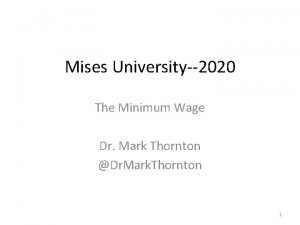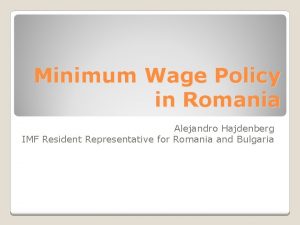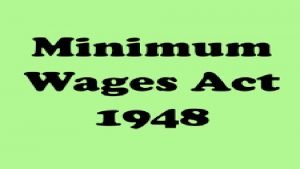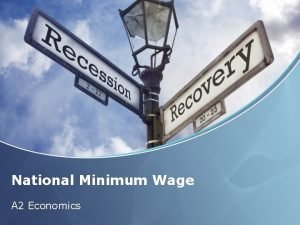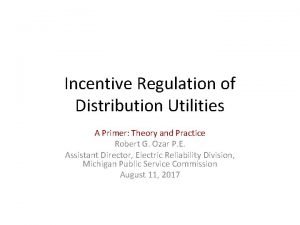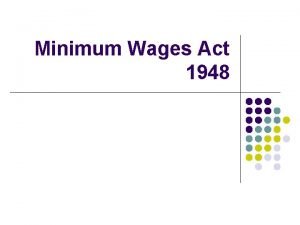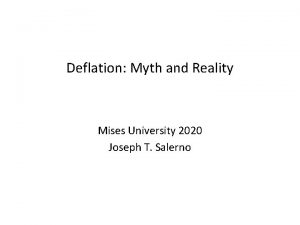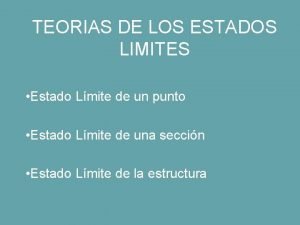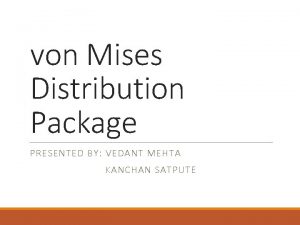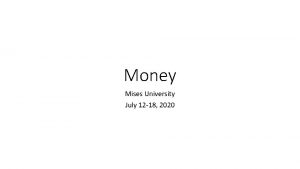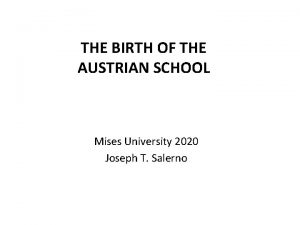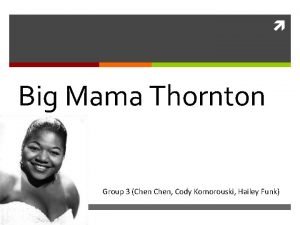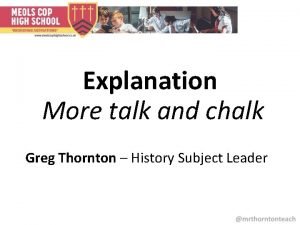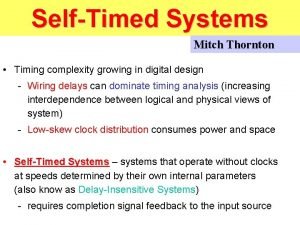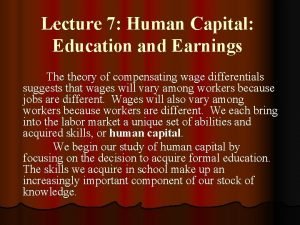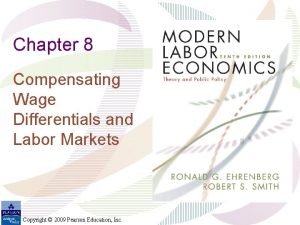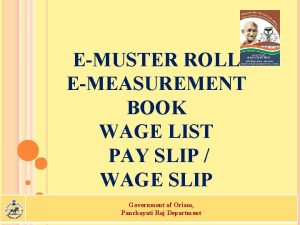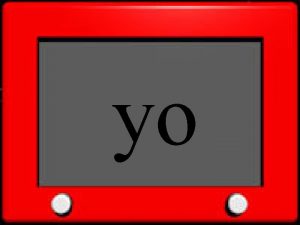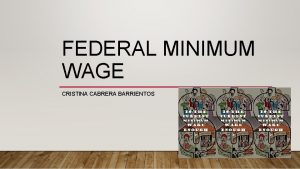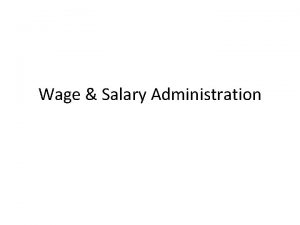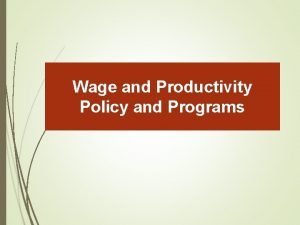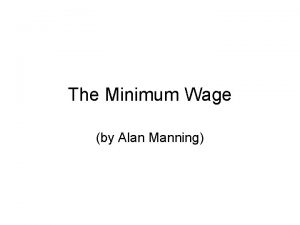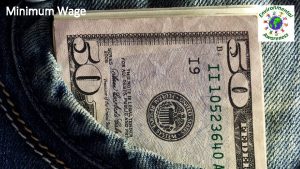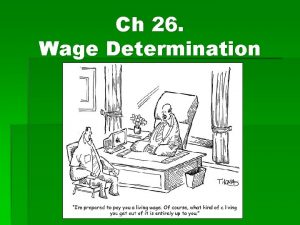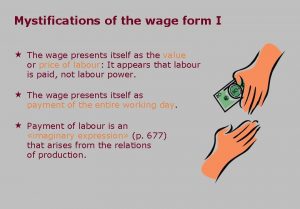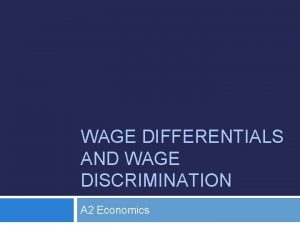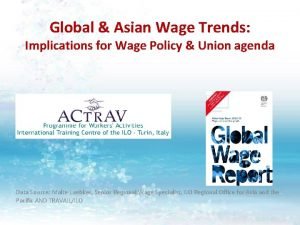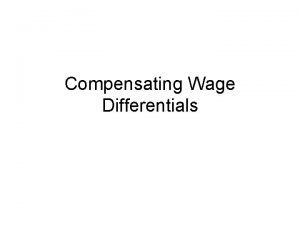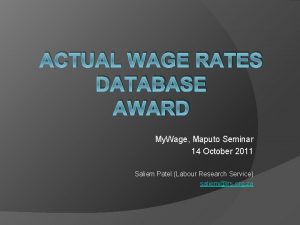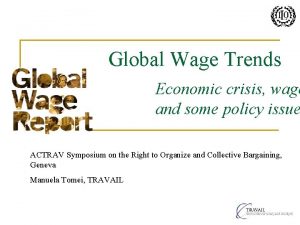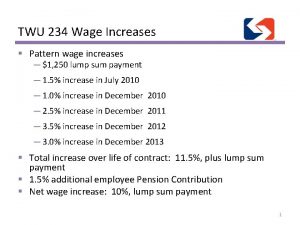Mises University2020 The Minimum Wage Dr Mark Thornton




































- Slides: 36

Mises University--2020 The Minimum Wage Dr. Mark Thornton @Dr. Mark. Thornton 1

Main Takeaways • 2020 Record number of increases by states and local governments • Austrian versus Mainstream approaches • MWL increases did not satisfy advocates • Progressive origins of the MWL 2

What is the Minimum Wage • • • Law that sets a “floor” on payments to labor You can pay higher wages, but not lower Federal MWL is $7. 25 per hour 31 States have MWL higher than federal Cites such as Seattle, San Francisco, Portland, Los Angeles, Kansas City, and DC have MWL higher than state levels 3

Conventional Analysis 4

What Does the MWL Do? On the one hand On the other hand • “There’s just no evidence that raising the minimum wage costs jobs, at least when the starting point is as low as it is in modern America. . . ” [this apparent defiance of the laws of supply and demand occurs because]“the market for labor isn’t like the market for, say, wheat, because workers are people. ” • “Any Econ 101 student can tell you the answer: The higher wage reduces the quantity of labor demanded, and hence leads to unemployment. Clearly these advocates (of MWL) very much want to believe that the price of labor– unlike that of gasoline, or Manhattan apartments–can be set based on considerations of justice, not supply and demand, without unpleasant side effects…” 5

Who Said Those Things? 6

Seattle: A Tale of Two Studies University of California-Berkeley University of Washington • Food Service Industry • $11 -$13 (18% increase) • Little/no change in wagepay and employment in full service (i. e. high skill) (tip and benefit exemption) 1%+ • Limited service increases less than expected by 4% • Hours worked decline by 13% • Not just food service but all industries with low wage workers • Reduced hours by 9%, increased wages by 3%, reduced monthly pay by $125 • Increased high skill $19+/hr. jobs 7

Reconciliation • Both studies say the same thing--increase wage (price) decreases hours worked (quantity demanded) and reduces monthly pay. • Both studies find relative substitution of high skill for low skilled jobs. • Seattle was Bubblesville in 2016. More construction cranes than NYC and LA combined! 8

Austrian Perspective on MWL (Labor) • MWL causes some combination of the following: • Unemployment – Fewer hours, Fewer jobs, Fewer employers (esp. small business) • Decrease job benefits – For example, Health insurance, Vacation & Sick days, Clean uniforms, etc. • Decrease job desirability – For example, Harder work, Less sanitary conditions, Less lighting, air conditioning, etc. 9

Continued (Capital) • Increased Demand for High Skilled Labor • Jobs are automated (partially or completely) 10

Discrimination • • Discrimination of minorities and inexperienced Unemployment Rate – 2 nd Quarter 2017 Total Unemployment = 4. 2% Total 16 -17 = 16. 4% White 16 -17 = 14. 7% Black 16 -17 = 27. 8% Hispanic 16 -17 = 19. 0% 11

EU Employment 2004 -2012 12

Teen Employment and the Last Hike in the Minimum Wage Law-2009 13

Conclusions • Wage rates determined market conditions, the relative scarcity of human and non-human resources. • There is no unemployment in a pure market economy. • Wage rate increases are driven by increases in capital (saving) and the extension and expansion of the structure of production. • Early job experience improves lifetime employment • MWL: Hurt their “intended” beneficiary 14

How do help the poor • • Eliminate MWL and compulsory education Job experience leads to higher wages Eliminate monopoly grants by government Lowers cost of living & increases opportunity Eliminate taxes on labor Higher wages & income, more jobs Eliminate the “Welfare Trap” 15

Labor Misconceptions • Employers determine wage rates and working conditions • Malthusian trap—subsistence wages • Unions helps labor, Labor laws help labor • Nonsense! Under capitalism real wages have been rising, work week has fallen, child labor has fallen, and workplace safety has consistently improved-without government • “unemployment” 1888. Marshall--one page 16

Ludwig von Mises • “It is a distortion to say that factories carried off the housewives from nurseries and the kitchens and the children from their play. These women had nothing to cook with and to feed their children. These children were destitute and starving. ” Human Action, Ch. 21 • Mass production from the factories of the Industrial Revolution were produced to sell to the masses! 17

Labor versus Leisure • Labor is a factor of production • More labor = more production – Limited by time (24 hrs/day) – Limited by ability (skills) – Limited by leisure (a desirable consumer good that must be foregone) • We work until the value or utility of the return from working is exceeded the disutility of giving up leisure whether producing goods for yourself or trading your labor to others. • MWL: Denies Low Productivity Workers 18

“Self Satisfaction” Counts • Some jobs provide direct satisfaction • Examples: Making wedding cakes and being an Austrian economist @MI—it’s a bonus! Except in the job market this bonus can reduce wages. • Some jobs are “displeasing. ” • Examples: Embalmers, prison guards, miners, sanitation engineers (dirty and dangerous), but increases wages. • MWL: Employers make work less satisfying 19

Benefits and Taxes Employers do not pay more than DMVP Increased benefits decrease take home pay Mandated benefits decrease take home pay Increased taxes decrease take home pay All 3 have contributed to stagnating wages (take home pay) and employment • MWL reduces side benefits • • • 20

Wage • • W=Payment for a unit of labor (hour, day, etc. ) Wages derived from DMVP P=Product (what is produced) V=Value (how much is a unit worth, Revenue) M=Marginal (at the margin, declining) D=Discounted (interest during time to market) DMRP: How much value/revenue does the employee produce for the employer? 21

How much is labor worth? • I plant something on your farm for you that will not be available for sale for one year at $20. • If interest rates are 5%, the most I’m willing to pay you is $19. • If you were willing to accept my $15 offer, I would earn $4 profit and $1 in interest. • If your DMVP is $19 then other entrepreneurs would bid up your wages. • Therefore: Labor is paid close to what it is worth 22

Supply of Labor • • Labor has alternative uses Increasing marginal value of leisure Supply of labor is upward sloping Therefore: More labor will only be supplied at higher wage rates. 23

Supply of Labor 24

Demand for Labor Based on DMVP (DMRP) How much does the employee contribute? Labor productivity is misleading It is not so much that the productivity of labor increases, rather- • It is an increase in capital and an extension and expansion of the structure of production • This increases MPP, DMVP and wage rates • • 25

Demand for Labor 26

Supply and Demand determines Wage Rates 27

Minimum Wage and Unemployment 28

Minimum Wage Laws • • “Effective” when set above market wage rates Causes compulsory unemployment Decreases “side benefits” Worsens working conditions Increases labor intensity Hurts the marginal worker/teens/minorities Increases the demand for high skilled workers All opposite of the “intentions” of MWL 29

Pass MWL Increases to Customers? • Businesses cannot pass increases on to customers or they would have already increased their prices. • MWL increases Cost, but not revenue. • Therefore Profits are lower, or turn to losses. • Losses lead to reduced output or shutdown. • Shutdowns reduce Supply • Reduced Supply leads to higher Prices 30

Conclusions • Government interventions (taxes, mandated benefits) not necessary/harmful • Minimum wage => unemployment, worse working conditions • Discrimination caused by government intervention (when MWL Qs>Qd), Minority teen Unemployment 2 X White teen • High skilled labor benefits from making manual labor uncompetitive 31

Welfare vs. Work 126 anti-poverty programs $1 T/year Family of 4 = $17 k (MS) to $49 k (HI) Welfare benefits not taxed Welfare > Full time low skilled job in most states • Really no work requirements • Welfare rational in SR, Welfare Trap in LR • Poverty and lower economic growth • • 32

Labor-Related Questions • • Should we “reform” the Minimum Wage Law? Are people entitled to a “living wage”? Do labor unions protect labor against capital? What is causing the growing inequality of income and wealth? Are women paid less than men? Are there glass ceilings that prevent women and minority from reaching their potential? What causes unemployment? Slavery? Sweatshops? The End of Work? 33

Answers to Labor Related Questions What is labor? Heterogeneous What determines wage rate and hours? What makes wage rates go up and down? What do government interventions do for labor? • What causes unemployment? • What do labor unions do? • • 34

We stop working because: • The Marginal Utility of our Production decreases (the value of our marginal product) • The Marginal Utility of our Leisure increases • Eventually the utility of leisure lost outweighs the utility or return from labor • True with wage labor too. 35

Unemployment and Discrimination 36
 Minimum wage
Minimum wage Minimum wage romania
Minimum wage romania Liberals vs conservatives minimum wage
Liberals vs conservatives minimum wage Croatia minimum wage
Croatia minimum wage The minimum wage act 1948
The minimum wage act 1948 How does rentals affect filipino entrepreneurs?
How does rentals affect filipino entrepreneurs? Minimum wage argument
Minimum wage argument Minimum wage essay outline
Minimum wage essay outline Disadvantage of raising minimum wage
Disadvantage of raising minimum wage The minimum wages act 1948
The minimum wages act 1948 Slovakia minimum wage
Slovakia minimum wage Mises university
Mises university Tensiones de von mises
Tensiones de von mises Von mises distribution python
Von mises distribution python Von mises theory
Von mises theory Trabajo virtual
Trabajo virtual Castigliano theorem
Castigliano theorem Mises university
Mises university Mises university
Mises university Mises u
Mises u Absolute maxima and local maxima
Absolute maxima and local maxima Prashan patel
Prashan patel Katherine thornton statement
Katherine thornton statement Tim thornton uw
Tim thornton uw Thornton ward lynfield mount hospital
Thornton ward lynfield mount hospital Grant thornton
Grant thornton Big mama thornton biography
Big mama thornton biography Thornton family tree
Thornton family tree Greg thornton history
Greg thornton history Thornton center rome ga
Thornton center rome ga Mitch thornton
Mitch thornton David quirke thornton
David quirke thornton Wage schooling locus
Wage schooling locus Statutory bonus
Statutory bonus Hedonic wage model
Hedonic wage model Wage roll
Wage roll What is a wage
What is a wage
